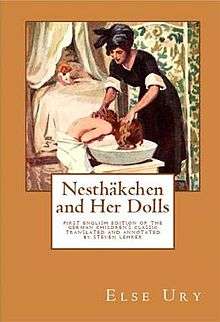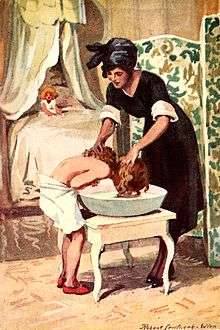Nesthäkchen and Her Dolls
A Nesthäkchen is the youngest child in a family. Else Ury's Nesthäkchen is a Berlin doctor's daughter, Annemarie Braun, a slim, golden blond, quintessential German girl. The ten-book Nesthäkchen series follows Annemarie from infancy (Nesthäkchen and Her Dolls) to old age and grandchildren (Nesthäkchen with White Hair).[1] The first volume of the series, originally published by Meidinger's Jugendschriftenverlag Berlin 1913, tells the story of Annemarie's early life.[2][3]
 | |
| Author | Else Ury |
|---|---|
| Original title | Nesthäkchen und ihre Puppen |
| Translator | Steven Lehrer |
| Illustrator | Robert Sedlacek |
| Country | US |
| Language | English |
| Series | Nesthäkchen, volume 1 |
| Genre | Fiction/Adventure |
| Publisher | SF Tafel |
Publication date | 2016 |
| Media type | trade paper |
| Pages | 224 pp |
| ISBN | 1530642000 |
| Followed by | Nesthäkchen's First School Year |
Plot summary

The main character of the series is six-year-old Annemarie Braun. Since she is eleven years old at the outbreak of World War I, she must have been born in 1903. Volume 1 thus takes place in the German Empire. The family lives in the Berlin district, Charlottenburg, on Knesebeckstraße. Annemarie's father is Dr. Edmund Braun. Her mother Elsbeth is a housewife. Annemarie's older brothers are the virtuous Hans (the oldest) and the cheeky Klaus. The boys personify polar opposites, the two sides of Annemarie's character: on the one hand the wild, curious and venturesome Klaus, on the other hand, the honest, hard-working, industrious Hans. As the youngest child in the family, Annemarie is referred to as "Nesthäkchen," but she is also nicknamed "Lotte." Other residents of the Braun home are the cook Hanne, who refers to Annemarie as "her" child; the maid Frieda; the nanny Lena, called "Fräulein" by Annemarie; the dog Puck and Annemarie's canary Antics. The extended family includes a maternal grandmother and grandmother's sister Albertina. Mother Elsbeth's sister Kate lives on an estate in Silesia, "Arnsdorf," with Uncle Henry and her children Ellie, Herbert and Peter. Nesthäkchen and Her Dolls describes the everyday adventures of little Annemarie in the years 1909 and 1910. Because Annemarie is a "higher daughter," she is not allowed to play with the other (socially subordinate) children in the courtyard and she spends most of her time with her dolls. Her favorite is the doll Gerda. Often the "thoughts" of the dolls are portrayed. They represent moral authority and are the voice of Else Ury (for example, "Annemarie knew that doll Gerda did not agree with…"). When Gerda's doll wig comes off, Annemarie cuts off one of her own braids, which she believes will grow on her bald doll's head. To escape the chaos of house cleaning, Annemarie must usually go for a walk with her nanny. Annemarie hopes for rain. She has heard that when it rains, "the barometer falls" and decides to help by taking Father's barometer off the wall and dropping it on the floor. An organ grinder makes Annemarie forget the prohibition of playing with socially subordinate children. She dances with the other children in the courtyard and runs with them, behind the hurdy-gurdy man, through the streets of Charlottenburg. With a sailor girl, Lina, Annemarie trades her fine shoes for Lina's clogs. Annemarie visits her relatives on their estate, Arnsdorf, where the sheltered city child experiences the freedom of unsupervised play outdoors for the first time. As Annemarie is bored at home, her mother sends her to a nursery school, a surprisingly modern choice in the early 20th century. The book ends with the celebration of Christmas and a reflection on Annemarie's upcoming first school year. Annemarie holds a doll wedding to say farewell to her toys.
Critical reception
"The warm and inviting earliest adventures of a favorite children’s book character from another era." Kirkus Reviews [4]
Predecessor
Annemarie is a spirited and lively child, similar to Der Trotzkopf (literally: "The Stubborn Head") of author Emmy von Rhoden. Ilse Macket, von Rhoden's heroine, is a predecessor of Else Ury's Nesthäkchen, Annemarie Braun. Ilse, like Annemarie, is vivacious and frequently disobedient. Ilse is popular nevertheless, not because of tedious learned virtues, but because of her kindness, honesty and unpretentiousness. Like Annemarie, Ilse is her father's favorite.
Genre

The Nesthäkchen books represent a German literary genre, the Backfischroman, a girls' novel that describes maturation and was intended for readers 12 – 16 years old. A Backfisch ("teenage girl", literally "fish for frying") is a young girl between fourteen and seventeen years of age. The Backfischroman was in fashion between 1850 and 1950. It dealt overwhelmingly with stereotypes, traditional social images of growing girls absorbing societal norms. The stories ended in marriage, with the heroine becoming a Hausfrau. Among the most successful Backfischroman authors, beside Else Ury, were Magda Trott, Emmy von Rhoden with her Der Trotzkopf and Henny Koch. Ury intended to end the Nesthäkchen series with volume 6, Nesthäkchen Flies From the Nest, describing Nesthäkchen's marriage. Meidingers Jugendschriften Verlag, her Berlin publisher, was inundated with a flood of letters from Ury's young fans, begging for more Nesthäkchen stories. After some hesitation, Ury wrote four more Nesthäkchen volumes, and included comments about her initial doubts in an epilogue to volume 7, Nesthäkchen and Her Chicks.
Author
Else Ury (November 1, 1877, in Berlin – January 13, 1943, in the Auschwitz concentration camp) was a German writer and children's book author. Her best-known character is the blonde doctor's daughter Annemarie Braun, whose life from childhood to old age is told in the ten volumes of the highly successful Nesthäkchen series. The books, the six-part TV series Nesthäkchen (1983), based on the first three volumes, as well as the new DVD edition (2005) caught the attention of millions of readers and viewers.[5][6][7][8]
References
- Jennifer Redmann. Nostalgia and Optimism in Else Ury's "Nesthäkchen" Books for Young Girls in the Weimar Republic. The German Quarterly, Vol. 79, No. 4 (Fall, 2006), pp. 465-483
- Nesthäkchen and Her Dolls on Google Books
- Nesthäkchen and Her Dolls in the Library of Congress Catalog
- Kirkus Review of Nesthäkchen and her Dolls
- Patricia M. Mazón. Gender and the Modern Research University: The Admission of Women to German Higher Education, 1865-1914. Stanford University Press; 1 edition (August 4, 2003) pp 166-175
- Marianne Brentzel. Nesthäkchen kommt ins KZ. FISCHER Taschenbuch; Auflage: 1., Aufl. (März 2003)
- Barbara Asper. Wiedersehen mit Nesthäkchen: Else Ury aus heutiger Sicht. TEXTPUNKT Verlag; Auflage: 1., Aufl. (1. November 2007)
- Melissa Eddy. Overlooked No More: Else Ury’s Stories Survived World War II. She Did Not. NY Times July 10, 2019